I’ve had Gotokuji bookmarked on my Google Maps for a while, ever since I saw the sea of Maneki Neko (Lucky Cat) figurines on Instagram a few years back. Gotokuji is located in Setagaya, one of the coolest neighborhoods in Tokyo, in my opinion. Finally, this year I got the chance to give them a visit!
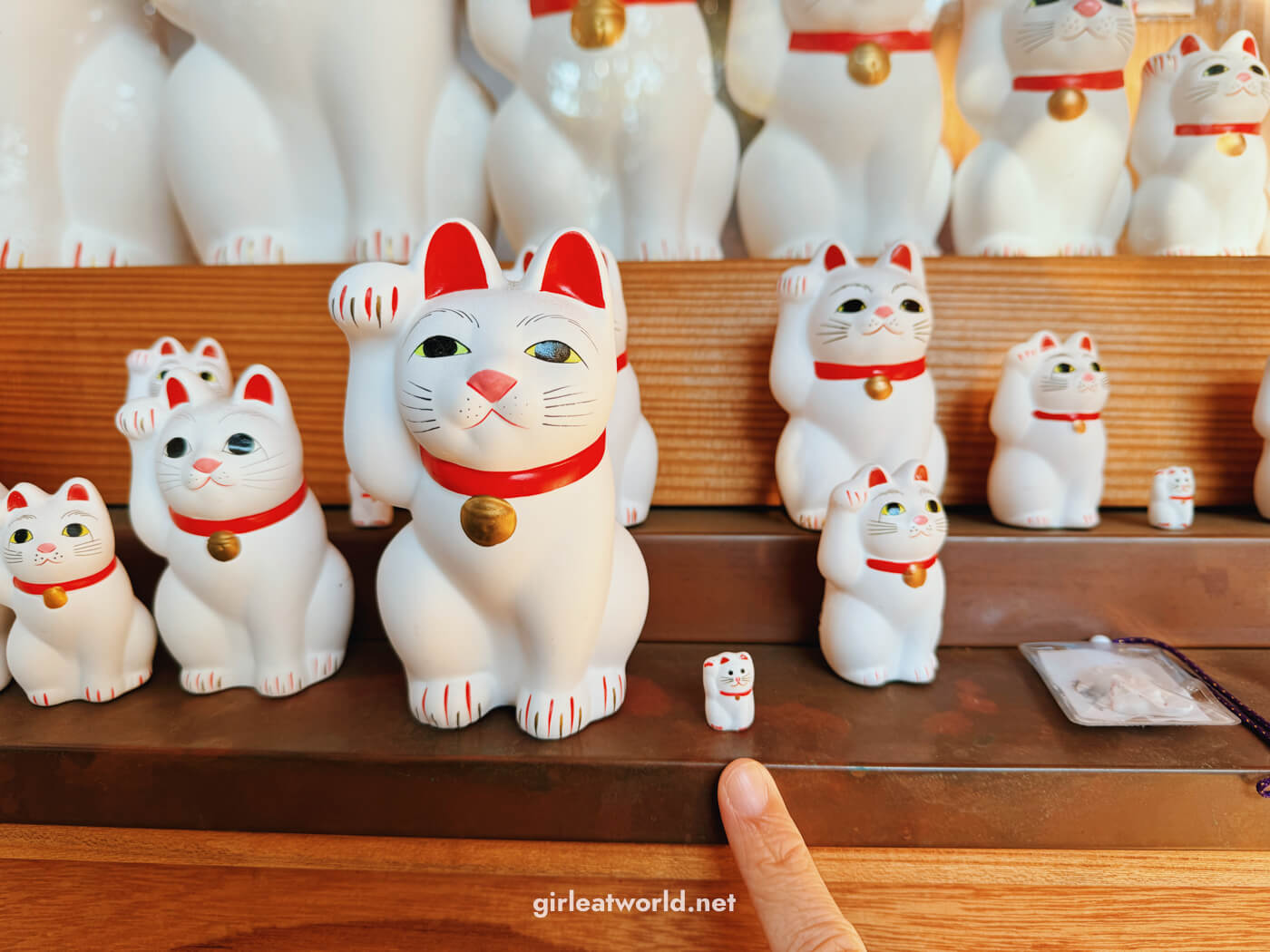
Here is how my visit to Gotokuji went:
What is Maneki Neko?
Maneki Neko is a well-known symbol in Japanese culture. It is a white cat with red details and one of its paws raised. The name “Maneki Neko” translates to “beckoning cat“, a fitting name because the cat is believed to beckon good luck and fortune.

But pay close attention to which paw is raised – when the cat has its right paw up, it is believed bring fortune or money. When the left paw is raised, it is supposed to attract more people or customers. This is why you’ll often see Maneki Neko at the entrance of a restaurant or retail shop with its left paw raised.
While there are many stories about how Maneki Neko originated, one of the stories is that it first appeared at Gotokuji. Hence, that’s why Gotokuji became a lucky cat neighborhood.
How to get to Gotokuji
There are two ways to get to Gotokuji:
Option 1: Take the Odakyu line to Gotokuji station. This is a straightforward and easy direct line from Shinjuku station. The temple is about 12 minutes walk from Gotokuji station.
If you don’t want to walk that far, you can transfer to Tokyu-Setagaya tram line at Yamashita station, then take it one stop south to Miyanosaki station. From there, temple is less than 5 minutes walk away.
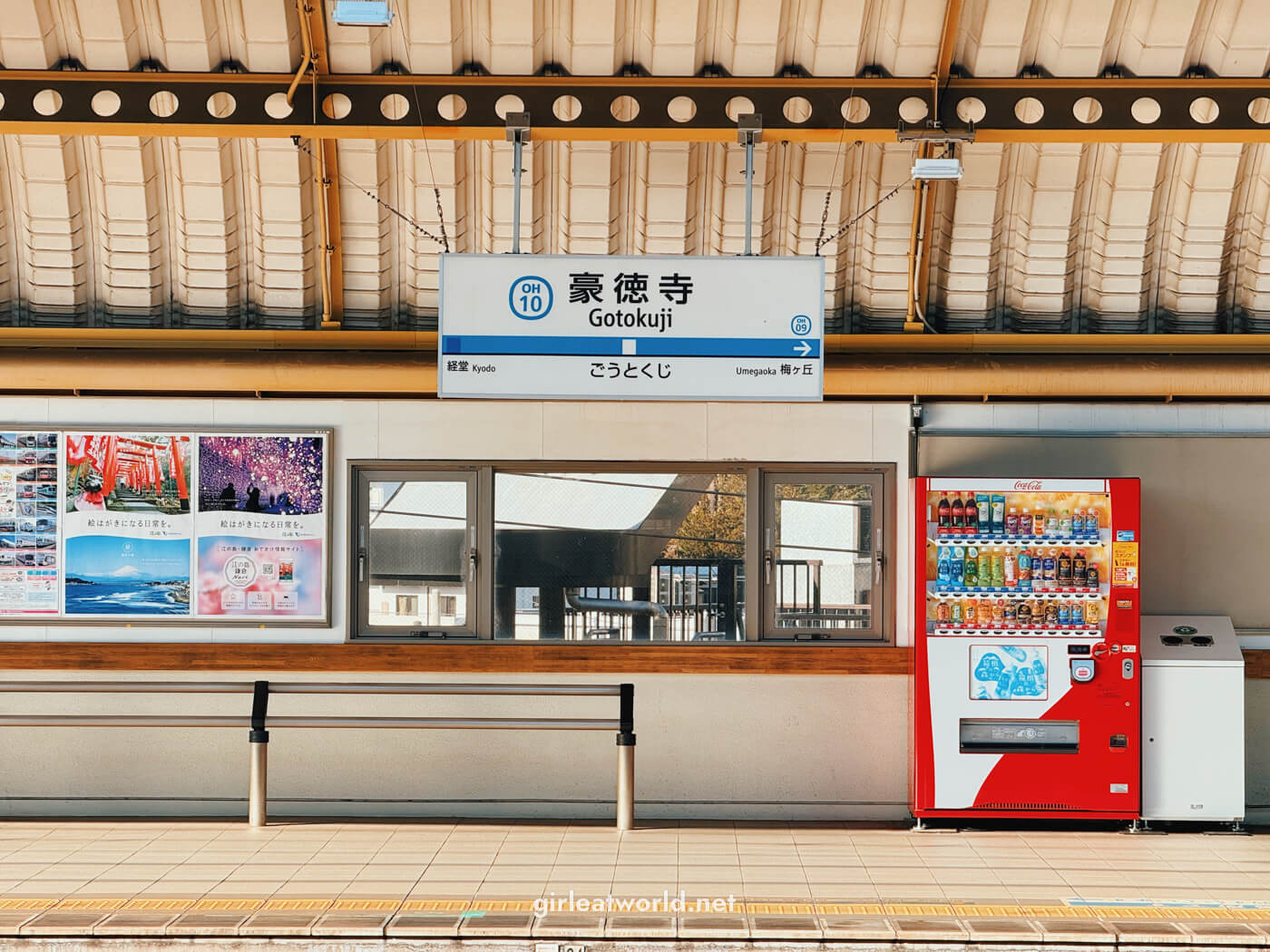
Option 2: Take the Den-en-toshi line to Sangenjaya station, then switch to the Tokyu-Setagaya tram line at the Sangenjaya station. The station names are both Sangenjaya but they are not the same station. You have to get out of the Den-en-toshi Sangenjaya station and walk about 5 minutes to the Tokyu-Setagaya Sangenjaya station.
It’s an easy transfer, just follow the sign that says “Setagaya Line Sangenjaya Station”. From there, ride the tram 7 stops west to Miyanosaki station. Then, the temple is less than 5 minutes walk away.
For some reason, Google Maps never seem to recommend taking the Tokyu-Setagaya tram line, but it’s actually the best option to get to Gotokuji! Read on to find out why.
Tips for visiting Gotokuji
Having made the journey to Gotokuji myself, here are a few tips that can make your trip easier:
- Set aside about 2 hours – Gotokuji is not a big area. You can probably wrap up a visit there in just under two hours.
- Plan to visit after 10 AM – I would also recommend that you visit after 10 AM. Most of the businesses only open at 10 AM.
- Don’t visit on a Monday – Daikenzan Gotokuji, the temple with all the Maneki Neko figurines, is open every day, but some businesses in the area are closed on Monday. So if you want to do anything else in the area aside from visiting the temple, avoid coming by on a Monday. You’ll most likely come to a very quiet neighborhood.
- Bring cash – While most of Tokyo seems to have adopted touchless credit card payment or payment using IC Card, I did not see this option in the smaller cafes in Gotokuji, so bring cash if you plan to get snacks!
And, here is what you can do in Gotokuji:
1. Visit the Maneki Neko Statue at the exit of Gotokuji Station
If you’re coming to the area via the Gotokuji Station on the Odakyu line, right outside the station you’ll see the first Maneki Neko item around the neighborhood: A statue right at the exit of the station!
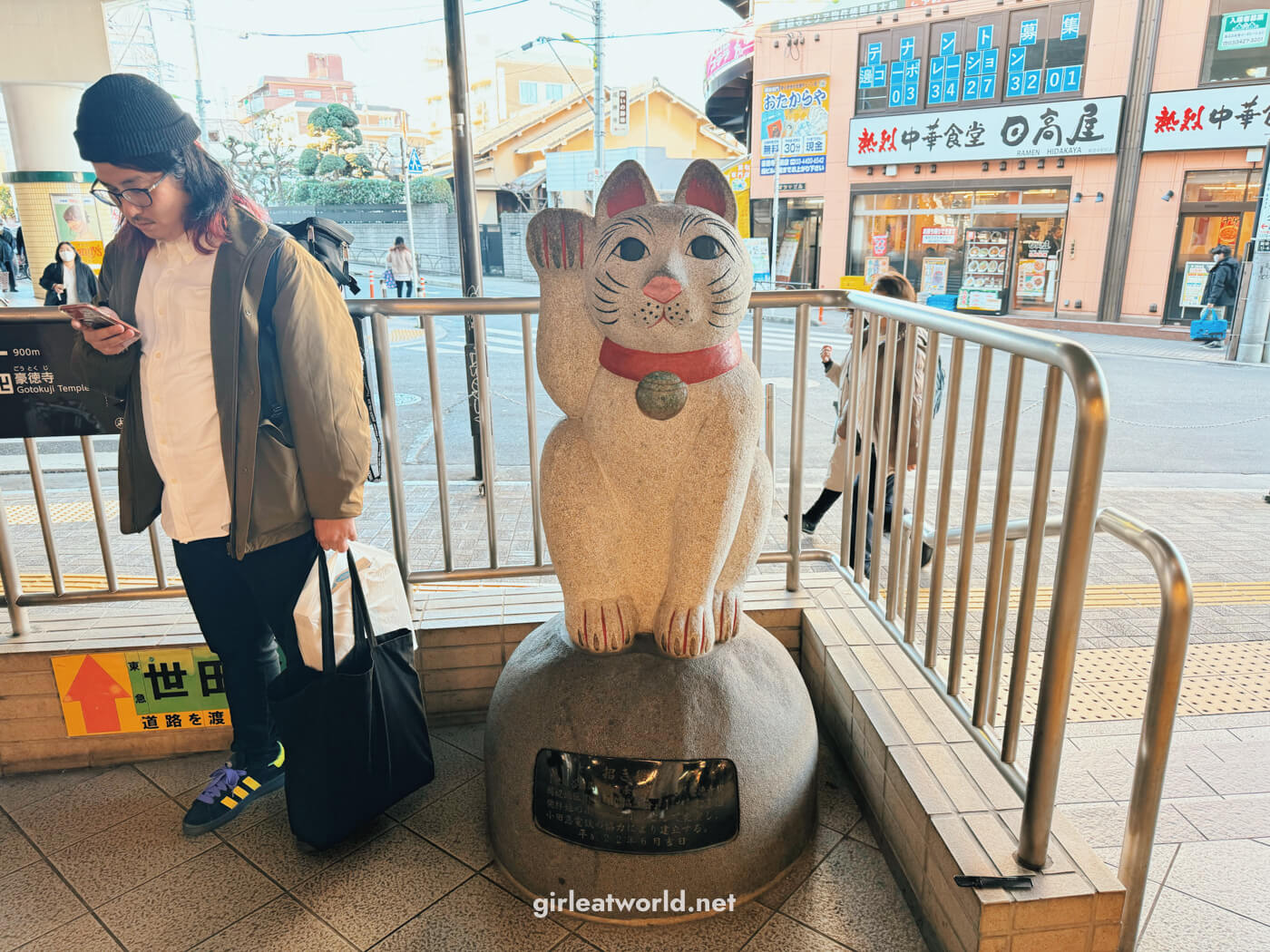
2. Wait for the rare Maneki Neko Lucky Cat Tram on Setagaya Line
Remember how I said the Sangenjaya station is the better way to come to Gotokuji? This is why.
Whether you’re coming from Sangenjaya or Gotokuji station, you’ll have the chance to transfer to the Setagaya Line. Unlike the other trains in Tokyo, Setagaya Line is a light rail line operated by Tokyu Corp. Compared to other trains in Tokyo, the trams on this line are small (only about 3-4 cars) and travels slower overground. They usually come in either solid pink, green, or blue. But once in a while – you might get lucky and get on the special Maneki Neko tram!
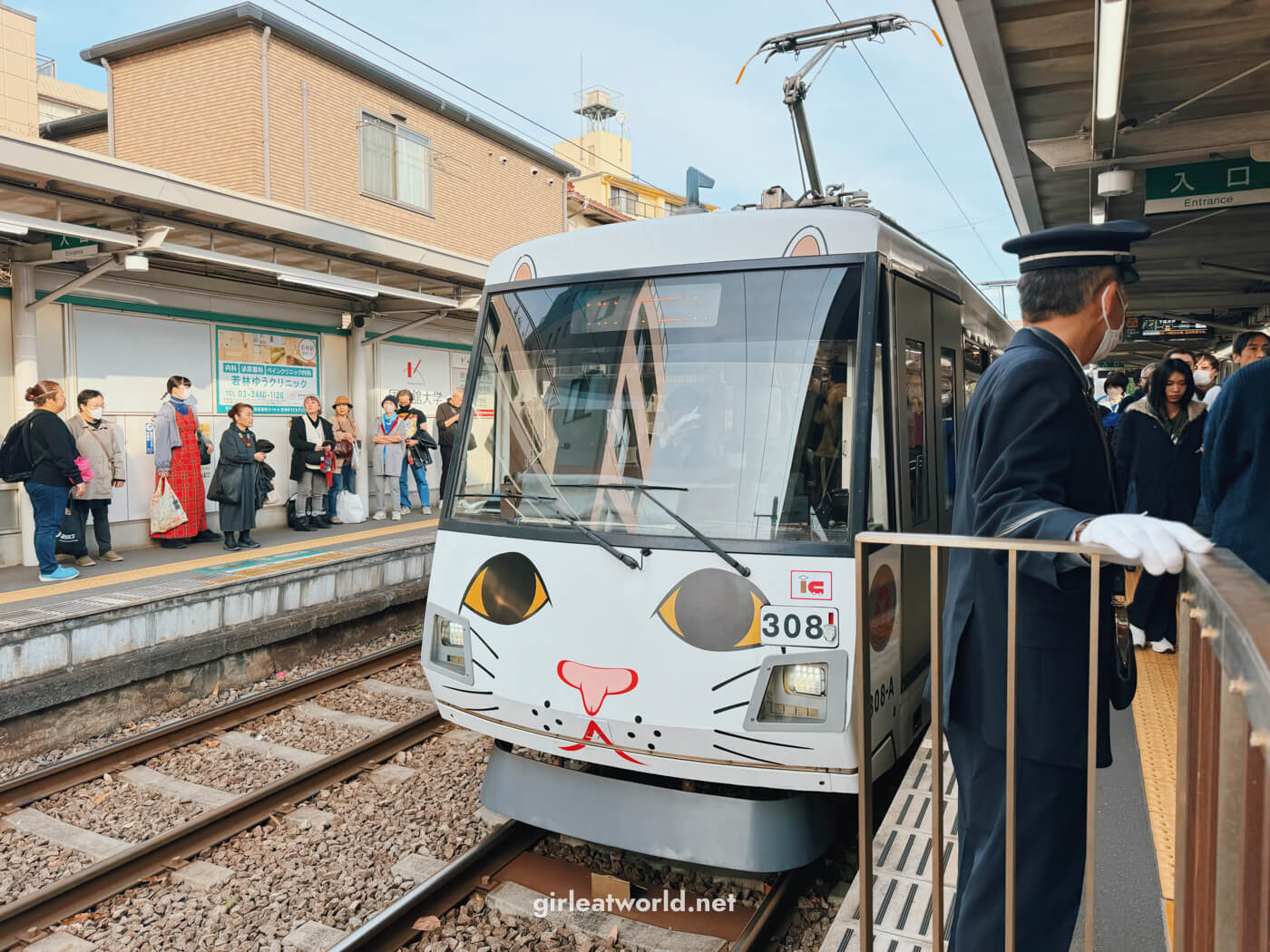
The official name of this tram is Kofuku no Maneki Neko Densha (幸福の招き猫電車), aka the lucky cat train. And I was indeed very lucky on my very first visit to Setagaya. The first tram I came across was a Maneki Neko train, and I gleefully boarded, thinking this is how all the trams look on that line. Imagine my disappointment when my friend Sam, who lives in the area and commutes daily using the Setagaya line, told me that the Maneki Neko tram is quite rare – he estimates that there is only about one Maneki Neko tram for every 10 trains!
I liked the idea of having to be “lucky” to get the Maneki Neko train, but they’re really hard to come by. I haven’t seen the Maneki Neko train since that first visit even though I’ve been to Setagaya a few more times (but I also haven’t been trying too hard).
So if you don’t want to wait indefinitely, luckily there is a timetable!
Maneki Neko Lucky Cat Train Schedule: Here is the schedule from Tokyu website. If this link stops working, you can try searching for the tram name in Japanese – 幸福の招き猫電車.
The schedule is released for the next 7 days, and there is no set daily time. From observing the historical schedule, the lucky cat tram generally comes only once or twice per hour from 7AM to 7PM. Sometimes it might start from 5AM or end at midnight depending on the day. On some days, the lucky cat train may not even be operating at all. The lucky cat train is indeed very rare!
Thankfully, I took photos on my lucky encounter with the Maneki Neko train. Here are a few cat-themed details you can look forward to inside the train:
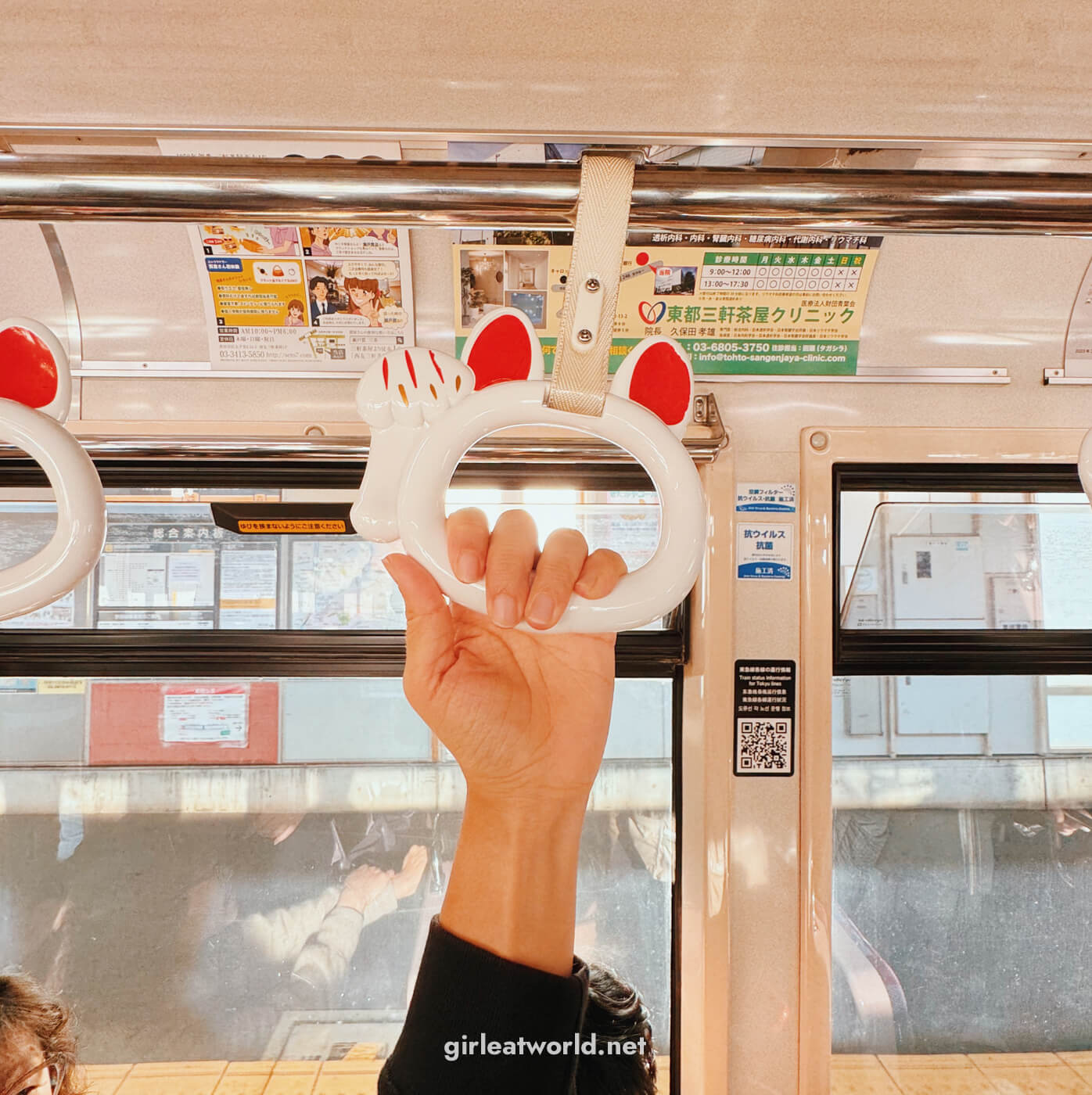

3. Visit Daikeizan Gotokuji
One of the main reasons why visitors come to Gotokuji is to visit none other than the famous Daikeizan Gotokuji, a Buddhist temple believed to be the birthplace of Maneki Neko.
Access Info: Admission to the temple is free. The temple is open every day from 6 AM to 5 PM. Learn more about Daikeizan Gotokuji here.
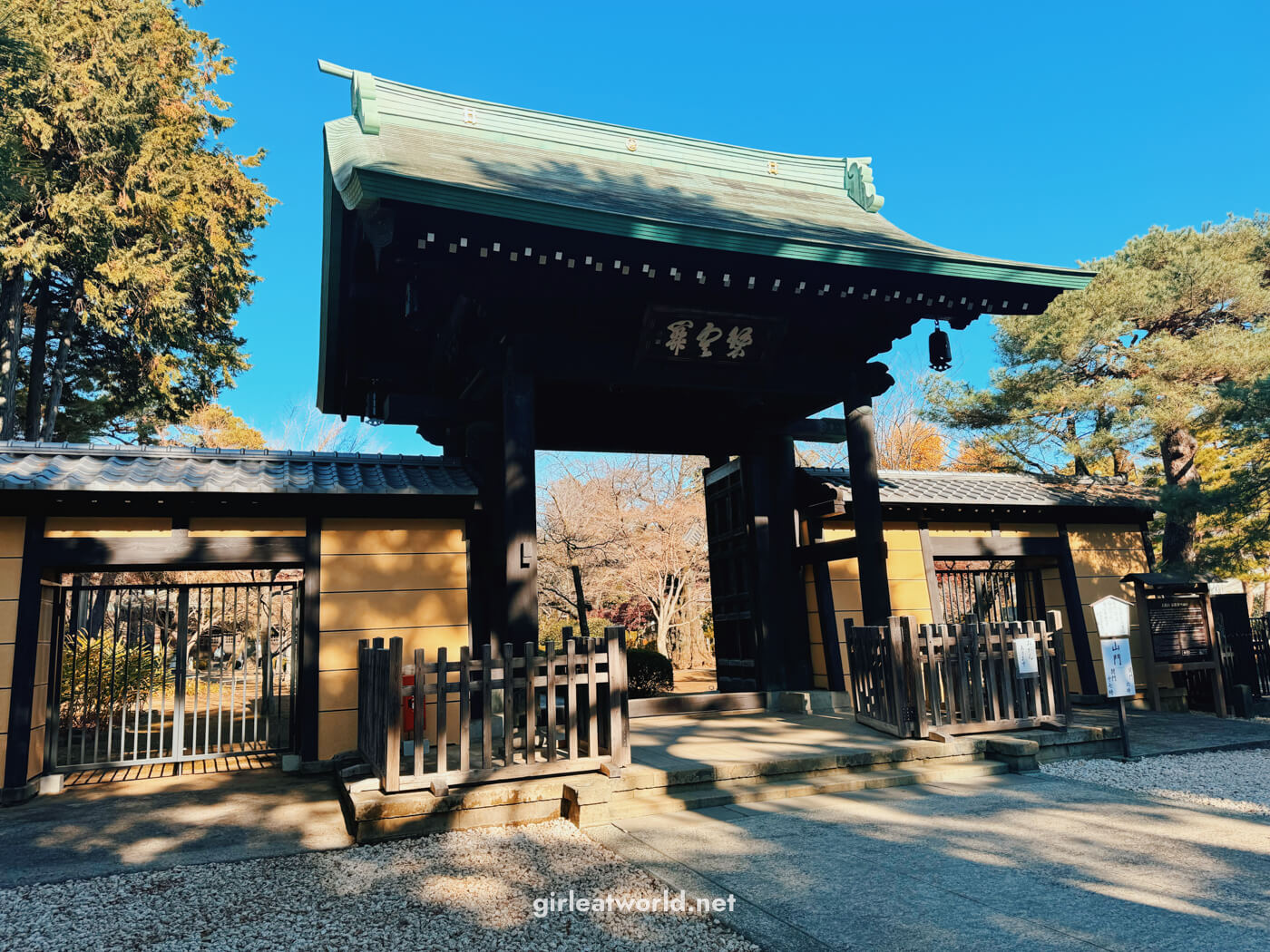
Once you enter the gate, there are a few other notable sights you can see before you get to the Maneki Neko part.
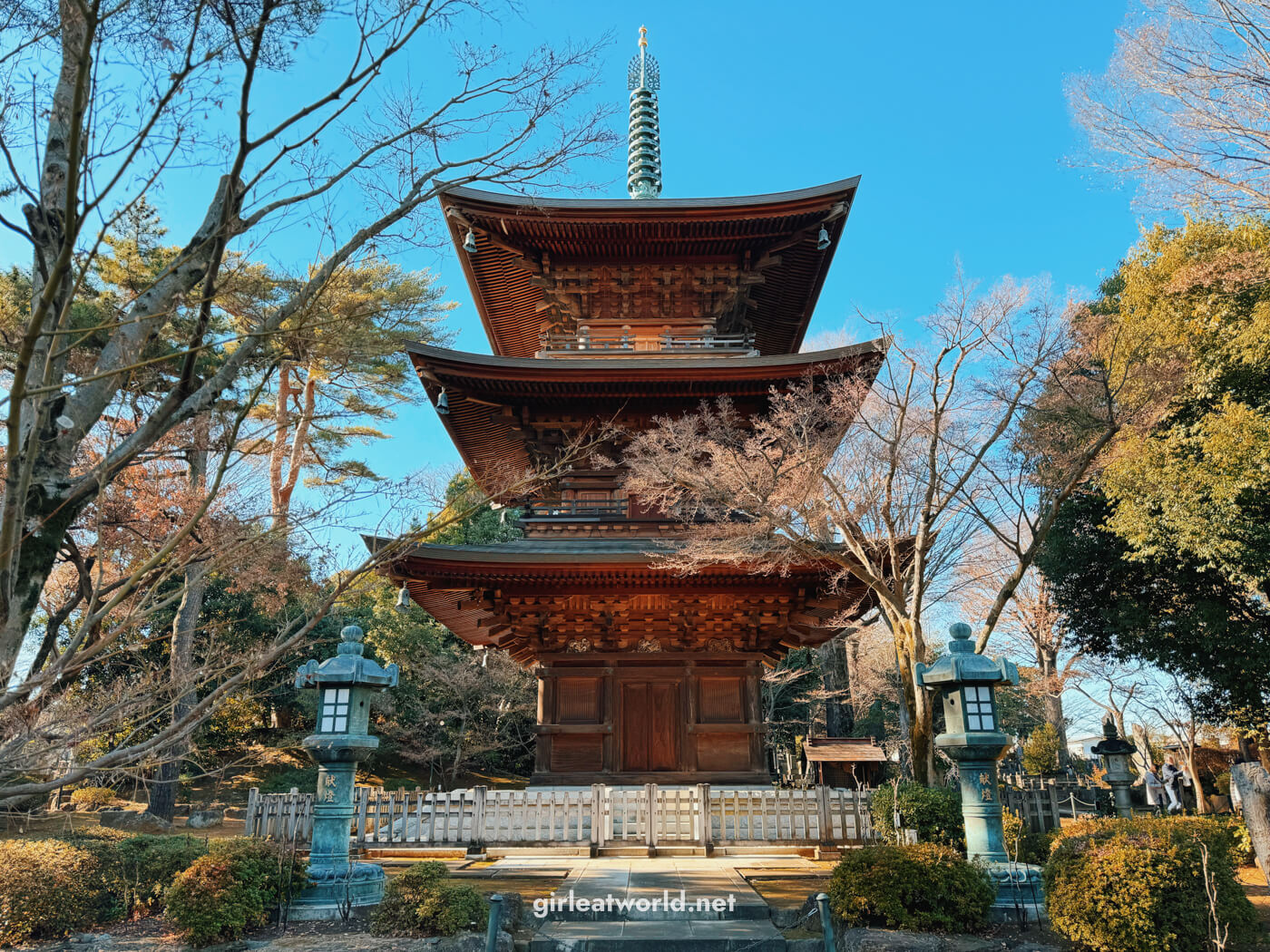

Turn left from Butsu-den behind the Komainu statue, and you’ll see a smaller gate with a black Maneki Neko statue. That’s how you’ll know you’ve come to the right place – Shofuku-den Maneki Neko.

Inside, you’ll find an abundance of the Maneki Neko figurines that have made this temple famous. They come in many sizes, the smallest one is just a little bit bigger than my fingernails! Super adorable.

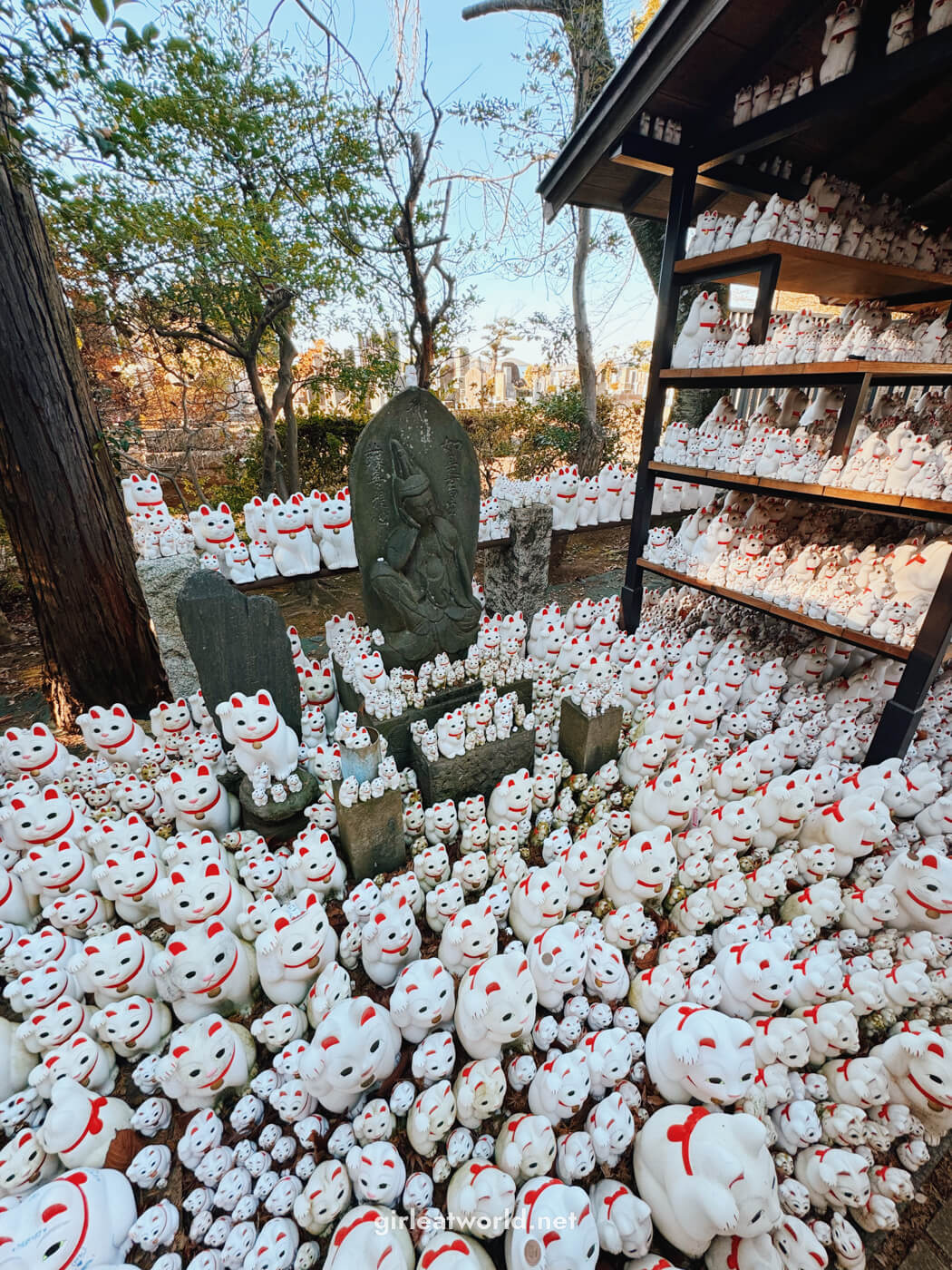
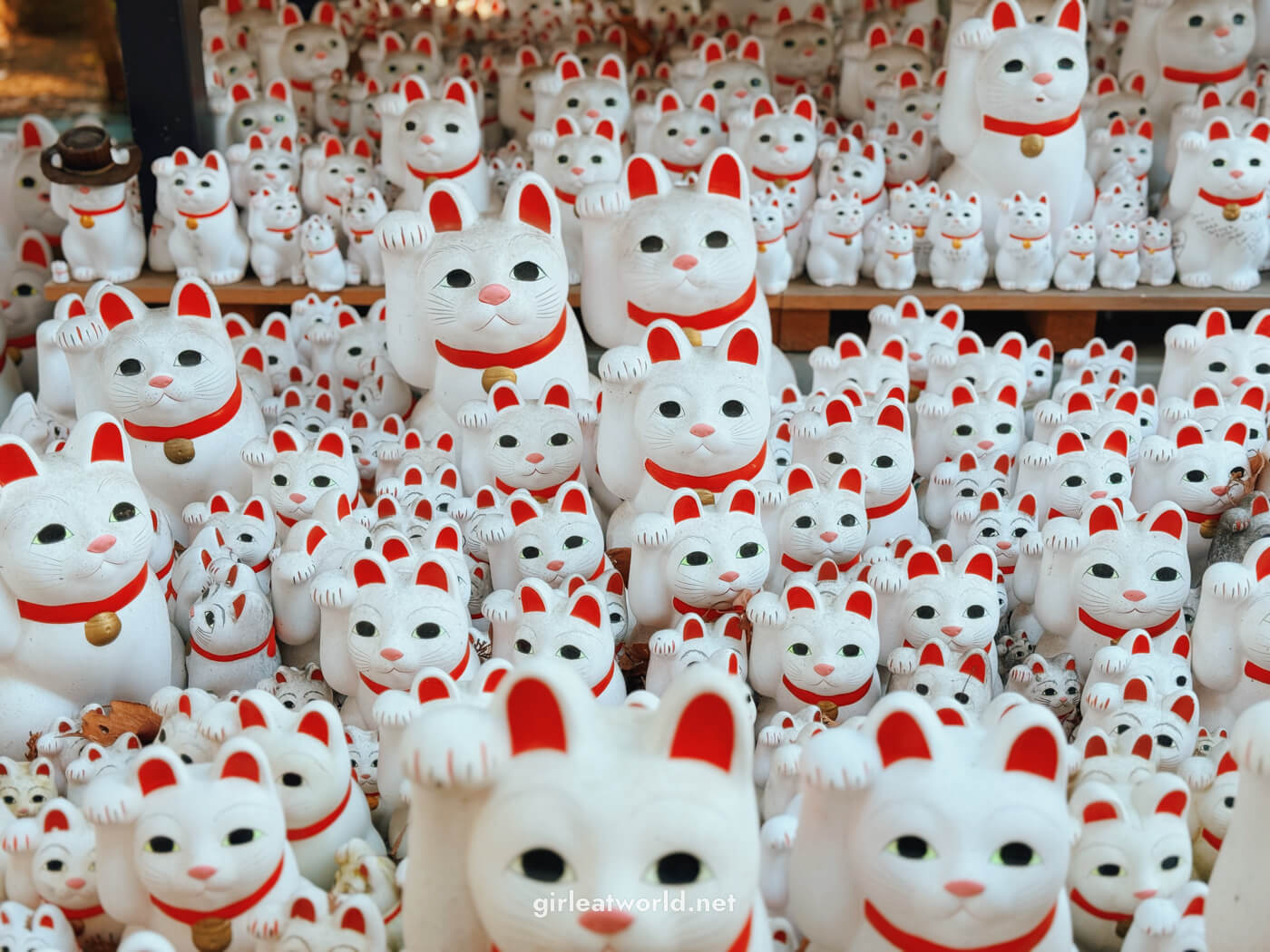
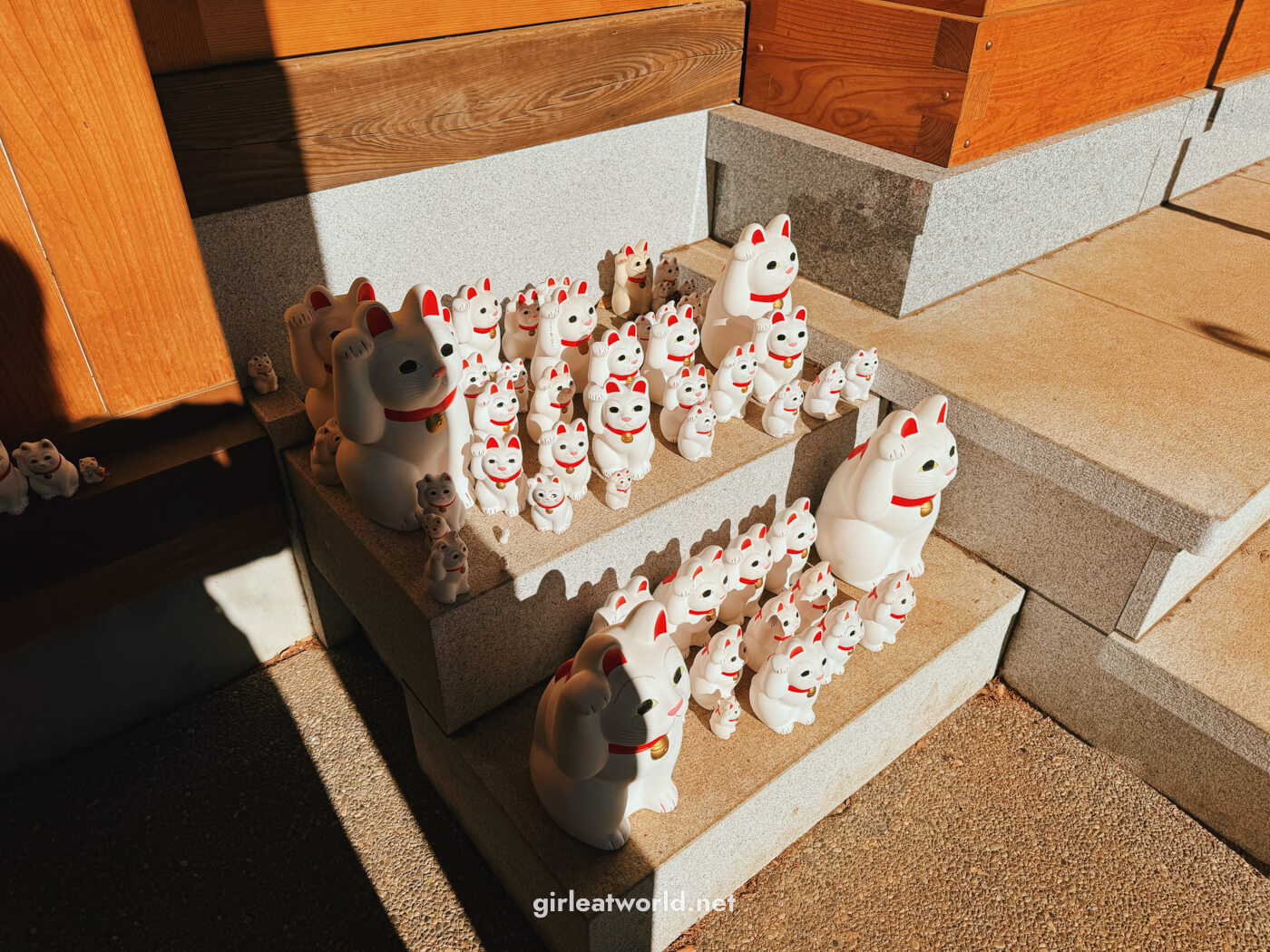
You can then spend as long as you want taking photos of the cat figurines. In my experience, the temple was popular with foreign tourists, but it was not crowded. Still, it would be difficult to get a photo of the cat hallway without anyone in it. For context, I visited on a Thursday in December, at around noon.
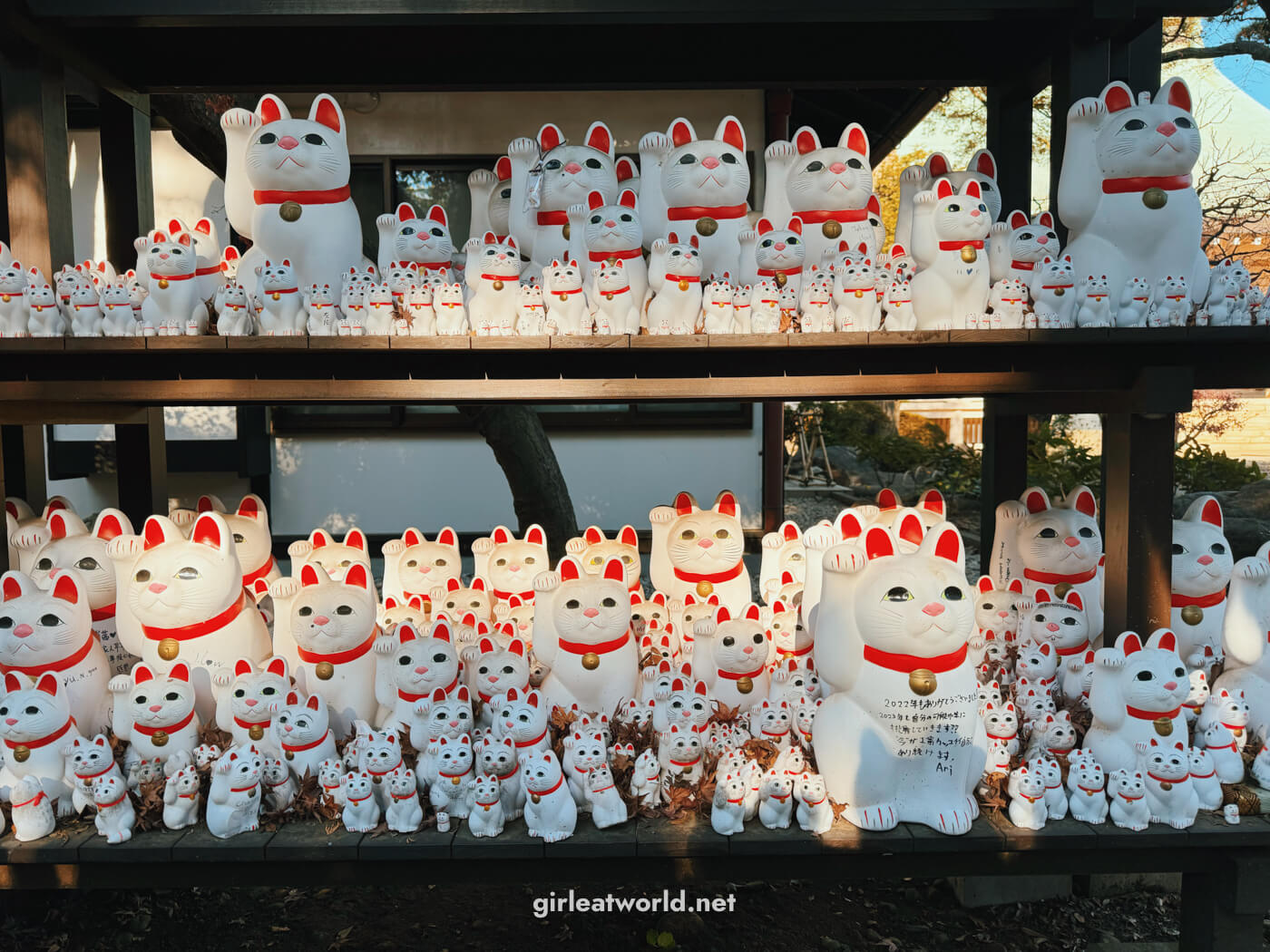
Pay attention to the notice pasted all around the temple, which explains how to treat a Maneki Neko figurine.
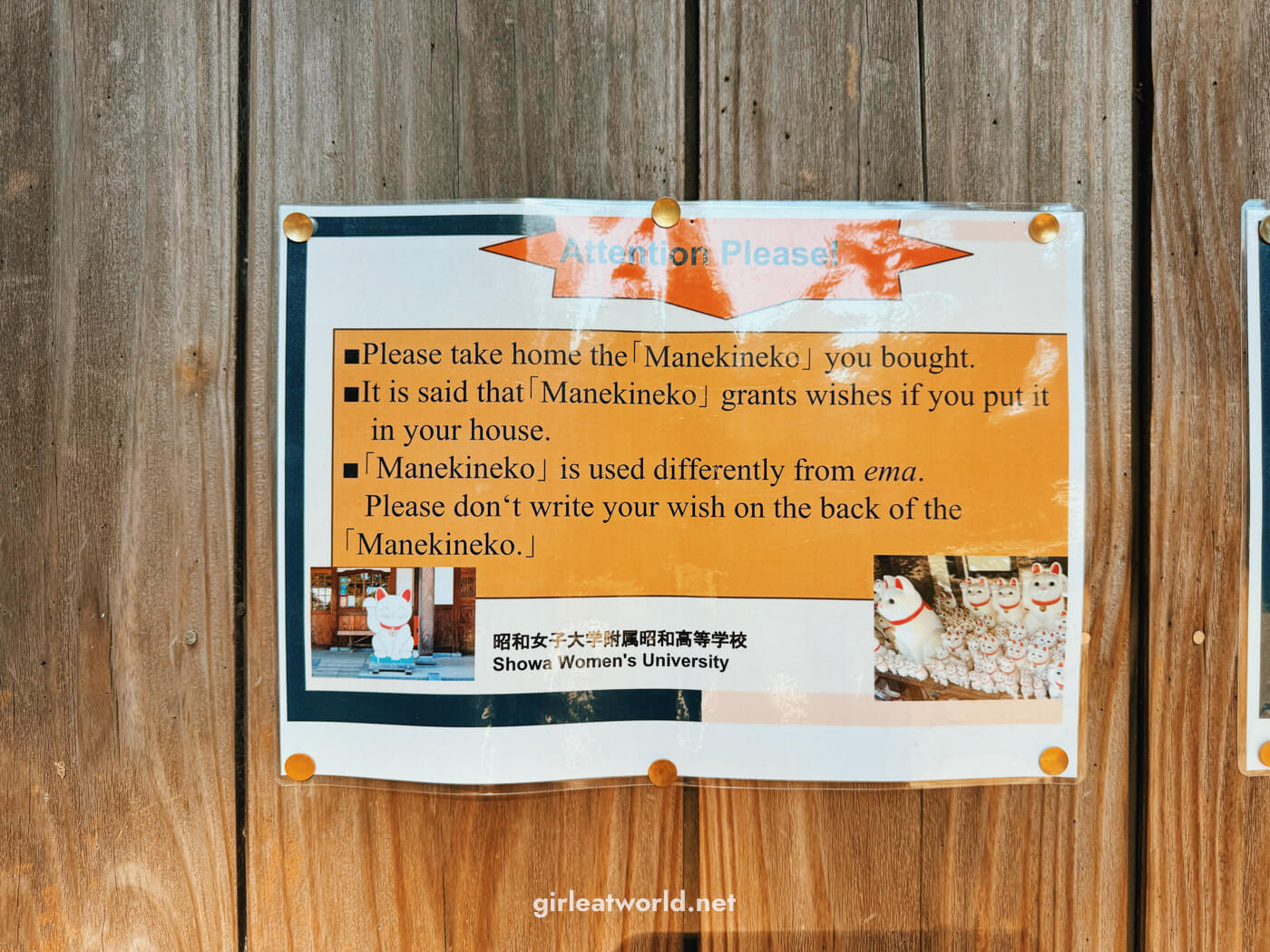
The notice did not elaborate further, but what you’re supposed to do is buy a Maneki Neko figurine from the temple shop, make a wish, and bring the figurine home. The figurine is believed to help make your wish come true. Then, when your wish has come true, you can bring back the Maneki Neko figurine to the temple so that the good luck will stay with you.
I saw quite a few Maneki Neko figurines with scribbles on them left at the temple, so I guess those people did not see this notice. If you’d like to write your wishes and leave them at the temple, you can purchase these wooden Ema instead:
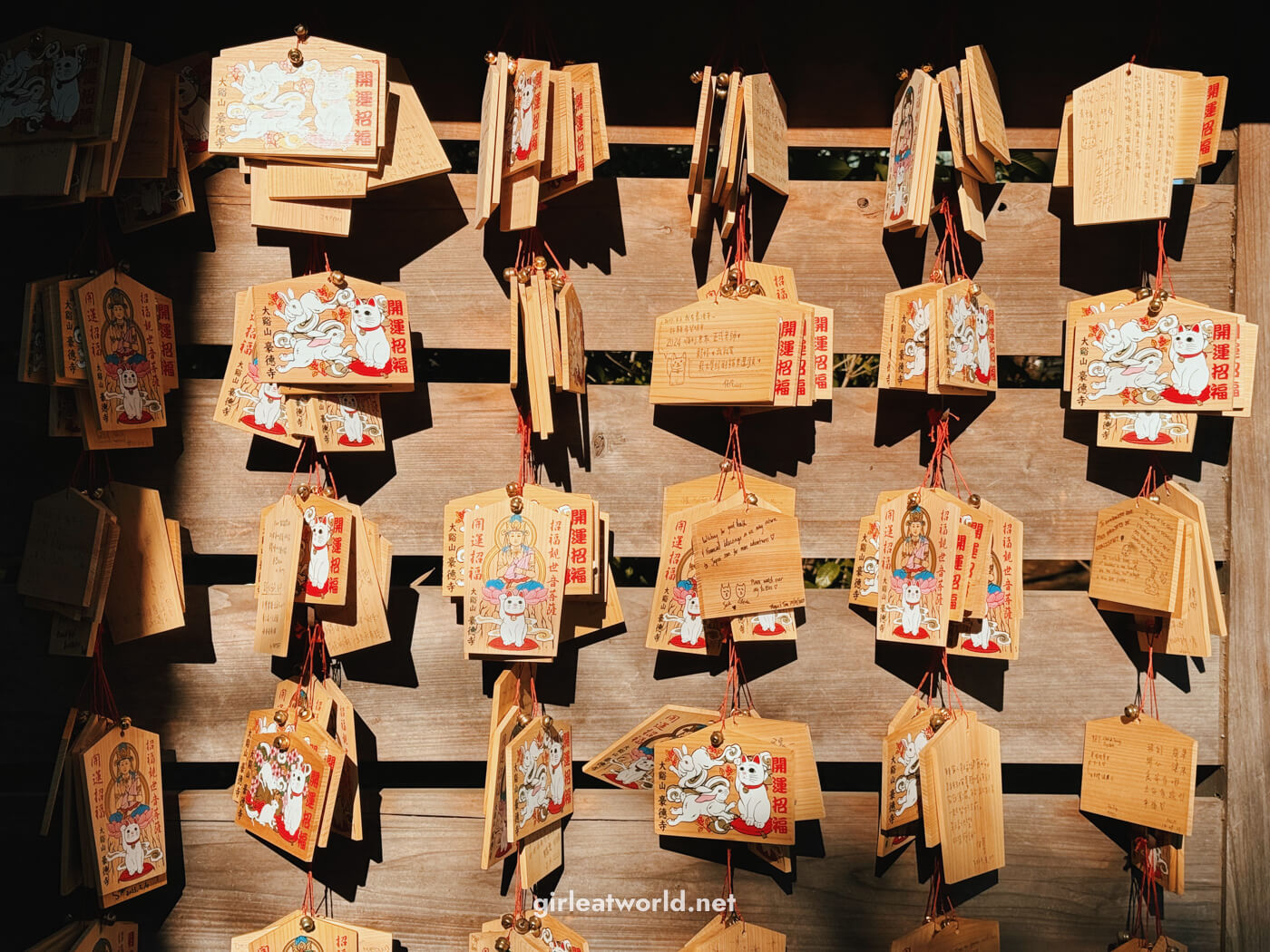
However, when I visited the temple in December, they unfortunately sold out of all items so I could not purchase anything. The cat figurines of all sizes and both wooden emas were already sold out.
4. Exploring around the Gotokuji neighborhood
As soon as you get off the train and exit Gotokuji station, you’ll find a small street filled with shops, bakeries, and cute cafes. I find it quite charming! It has a similar vibe to Shimokitazawa or Jiyugaoka, but even smaller and more quiet.
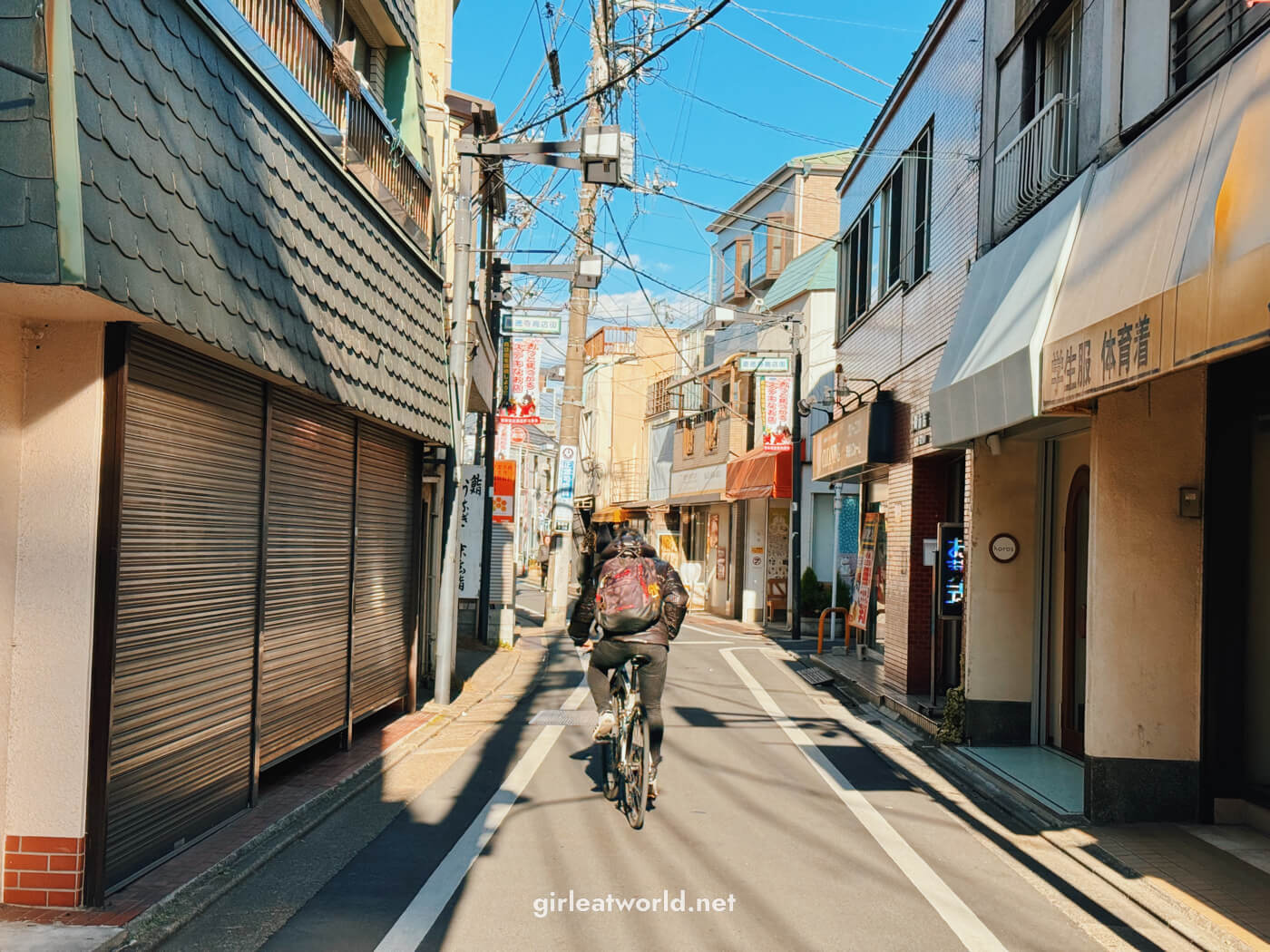
I’m sure you would have noticed that many of these shops sell Maneki Neko goodies, as well as a little Maneki Neko figurine or statue at the front of their shops.
And if you remember what I said before, take note of which paw is raised on the cats in front of the shop – yes, the cats in front of the stores all have their left paw raised! This is because the shops are hoping to attract more customers to the store.


Although not Maneki Neko-themed, coffee lovers will be glad to know that you can find good coffee in this area. One of them is right on that small street, called Iron Coffee.

5. Get Maneki Neko-themed pastries
Of course, because this is Japan, you can expect people to completely play into the Maneki Neko theme! Many bakeries and cafes would sell Maneki Neko-themed pastries.
Here are two places that I tried during my visit:
1. Shofuku-yaki Maneko Neko at Rarasand Setagaya
Opening Hours: 10 AM – 8 PM
Right on the small street outside Gotokuji Station, Rarasand should not be difficult to find.
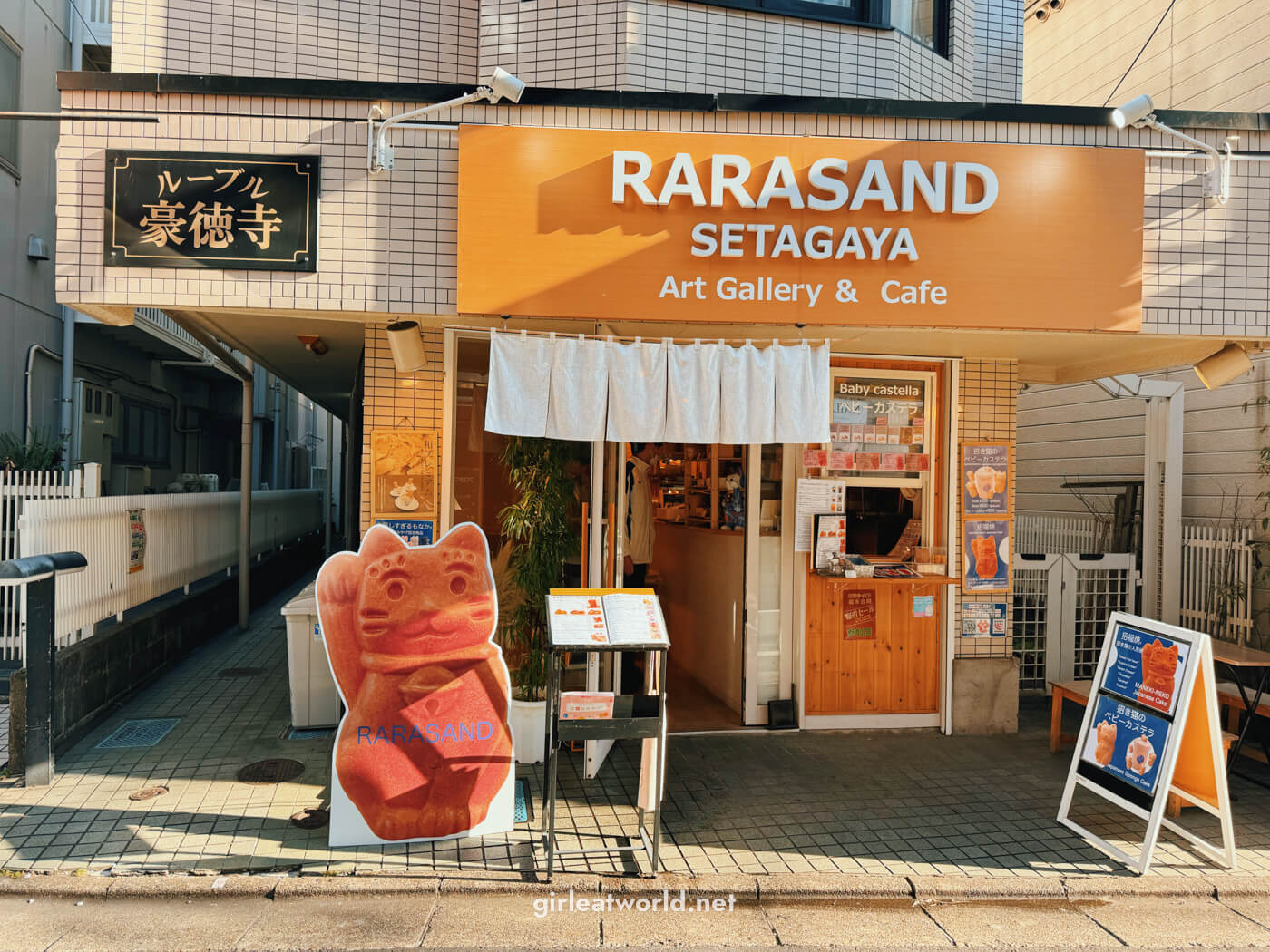
They have a few Maneki Neko pastries. The one that I tried was Shofuku-yaki, which is very similar to the beloved Taiyaki but shaped like Maneki Neko instead. It goes for 280 – 330 yen depending on the filling you choose.
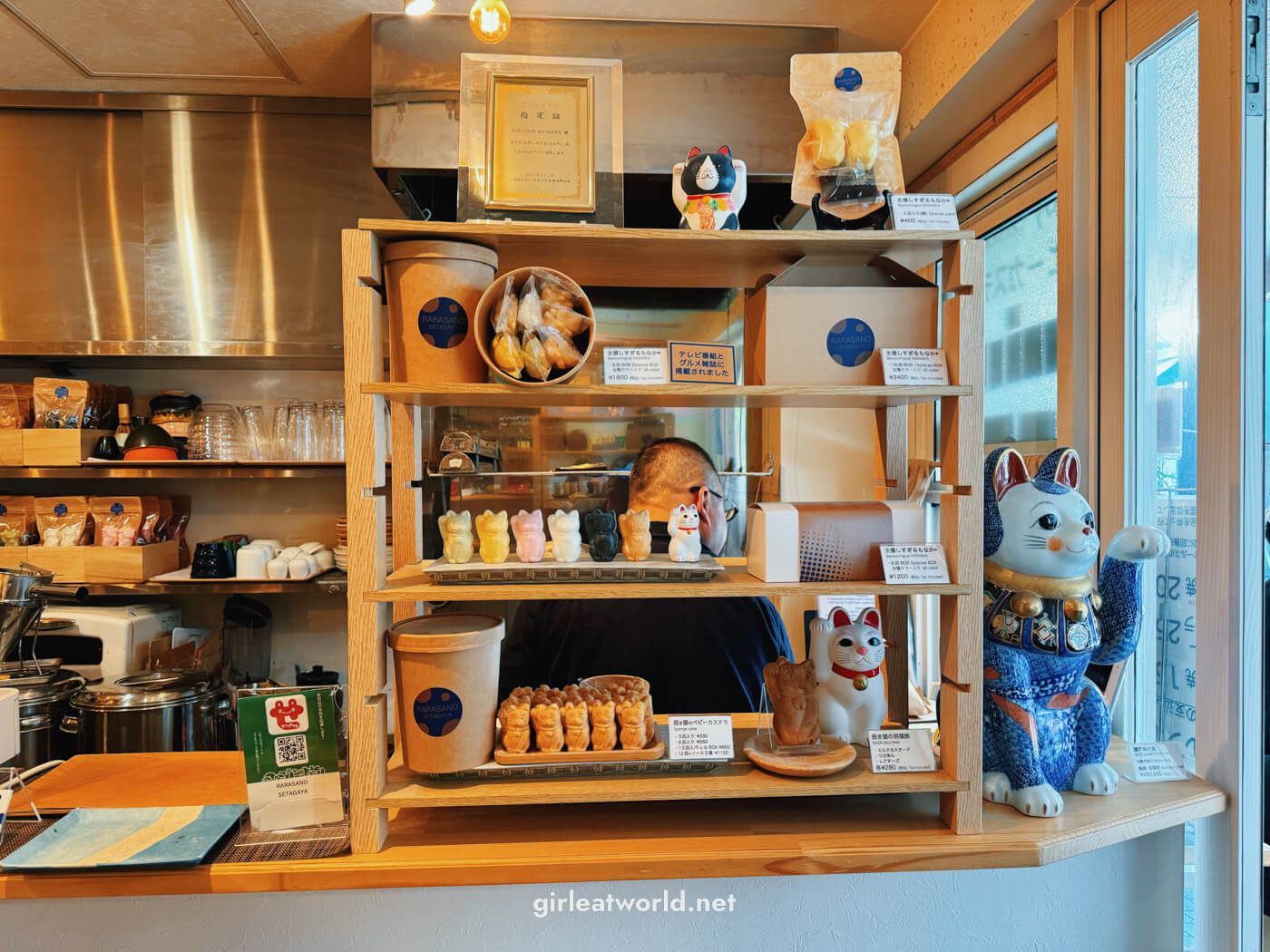
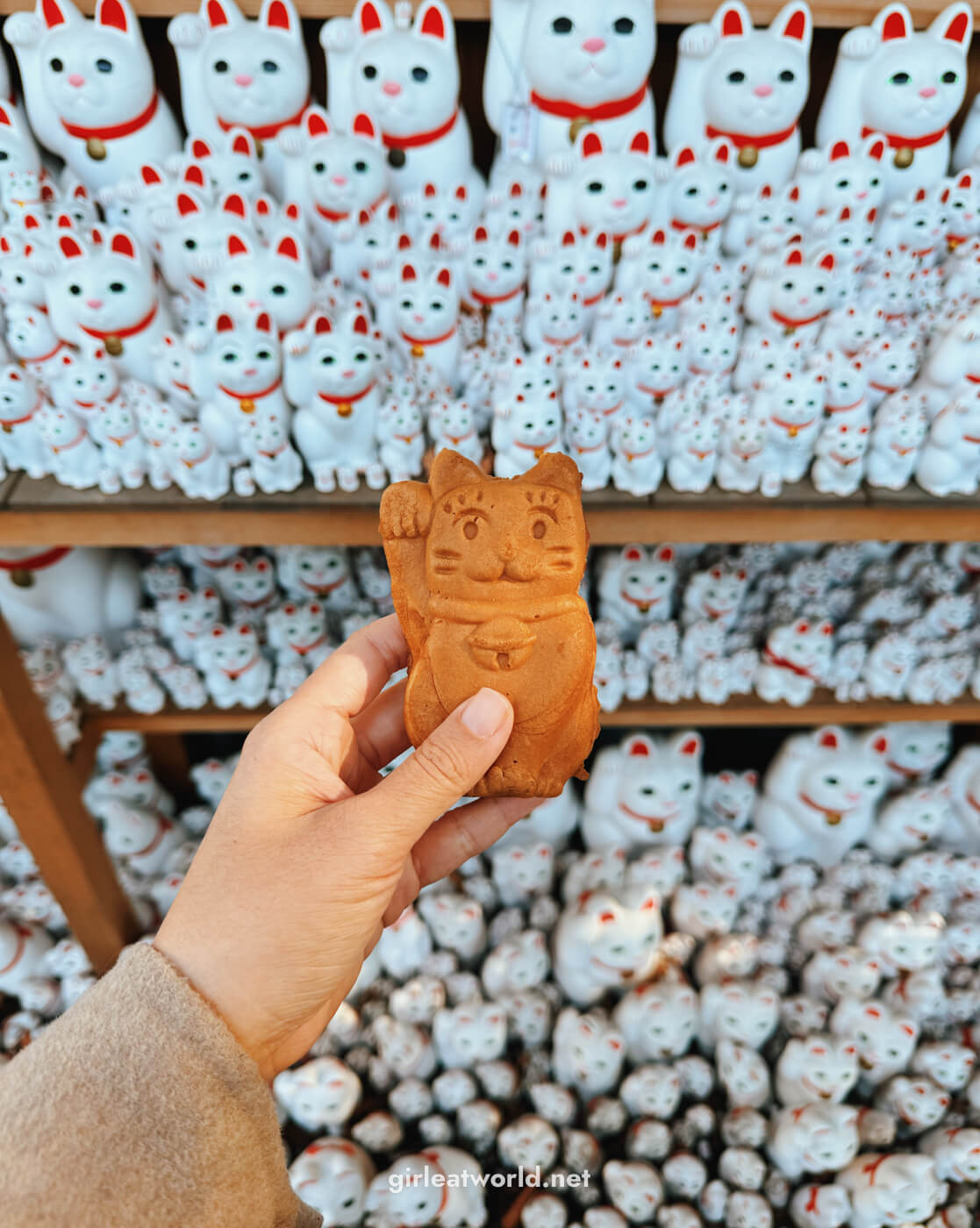
2. Maneki-Neko Dorayaki at Mahorodou Sougetsu
Opening Hours: 10 AM – 6 PM. Closed on Mondays.
Closer to Gotokuji Temple, on the other side of the railroad, is a small cafe selling cute Maneki Neko Dorayaki. Dorayaki is a classic Japanese snack, made of two pancakes with azuki (sweet red bean) filling, and the one they sold here is stamped with a Maneki Neko shape.
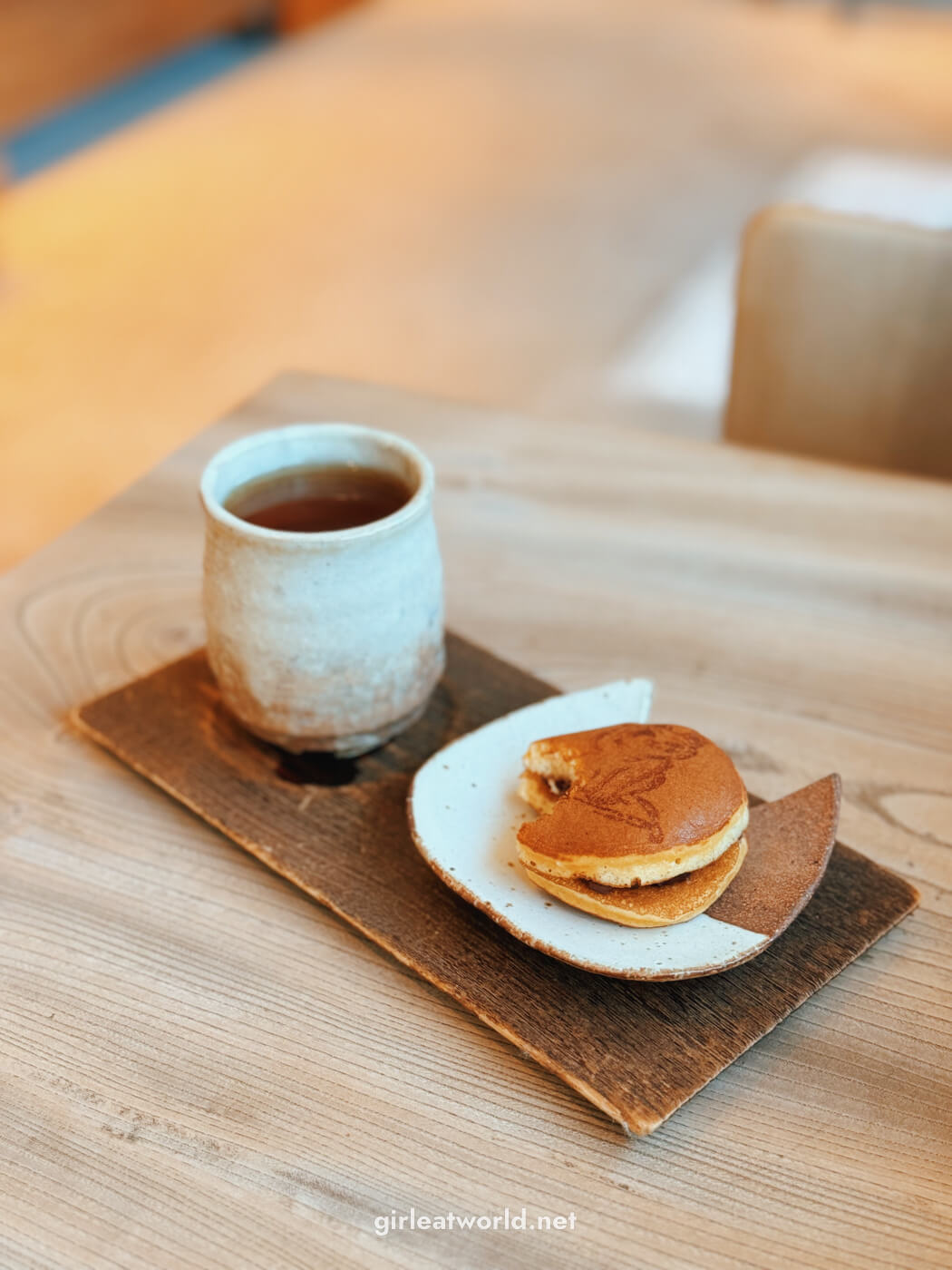
You can have the dorayaki to-go for 280 yen, but if you want to sit inside, you must buy a drink to go with it. I wanted to sit inside so I had the Dorayaki with a hot Houjicha (roasted rice tea) and the bill came out to be around 520 yen.
The restaurant played into the cat theme as well, by serving them on a cat-shaped ceramic plate.
I have this habit of turning over ceramic ware after I’m done eating because I want to find out where the shops get their plates. Well, I had a nice little surprise when I turned over the cat plate…
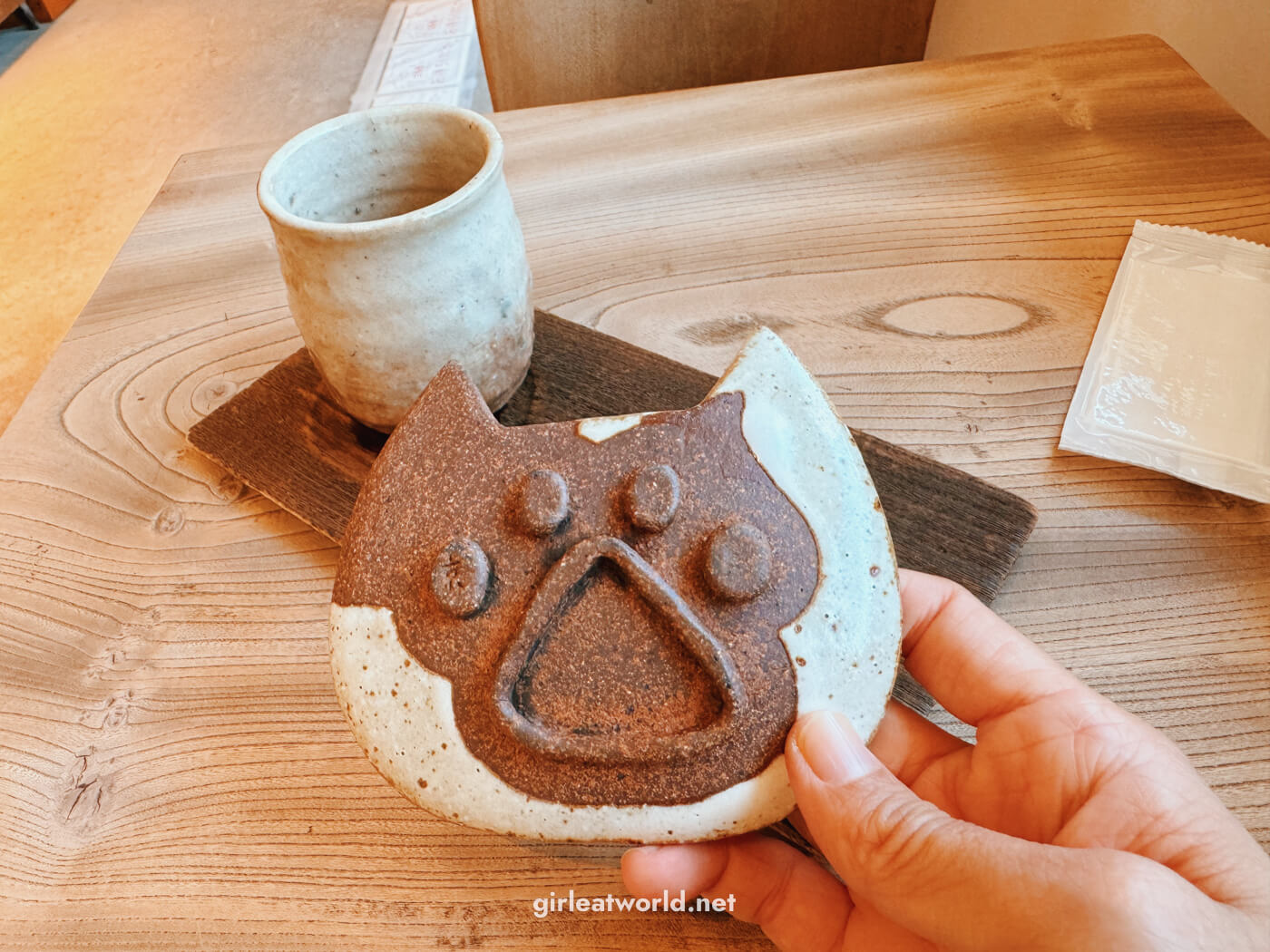
Such a cute, unexpected delightful detail 🐾 🥹 I love this about Japanese culture!
What else can you do in Setagaya and around?
Gotokuji is located in Setagaya, which is not very close to other typical tourist attractions in Tokyo. However, I think this neighborhood is one of Tokyo’s hidden gems. If you have some time, I encourage you to stay and explore around the area. Here’s some ideas:
1. Boroichi Flea Market
If you are extra lucky to be around in mid-December (15 to 16 December) or mid-January (15 to 16 January), you might be able to align your Gotokuji visit with Boroichi Flea Market. This is a long running tradition that has been going on since 1578. At Boroichi Flea Market, you can shop for vintage goods or eat street food at over 700 stalls that participate at the market (I chose the latter, of course!).
To get there, take the Setagaya tram line to Setagaya station, and walk down towards Boroichi street. You can then continue to walk west. To get back, use the Kamimachi station.
2. Sakura Shrine
If you happen to be around right before Sakura time, the famous Sakura Shrine is located in Setagaya, near Sakura Shinmachi station. They are famous for the early-blooming Sakura, which opens its petals about a month before the forecasted Sakura peak time.
3. Shoin Shrine
Just a few minutes walk from Shoin-jinja-mae station on the Setagaya tram line is Shoin Shrine. Usually torii gates at other shrines are painted in the vivid vermillion red color, but at Shoin Shrine, the main torii gate is painted an elegant black.
4. Midori Sushi in Umegaoka
Eating sushi while you are in Japan is undeniably a must-do. While staying at an Airbnb apartment in Tokyo, I got to know one of my roommates, a Japanese guy who kindly offered to drive me to his favorite local sushi joint. It’s called Midori Sushi – they are famous for being affordable yet offering high-quality food.

They have a few branches in Tokyo, but the original one is at Umegaoka and is located in a very local residential area. They are famous for shaping their nigiri such that the meat topping forms this very long “tail”, much longer than normal.
From Gotokuji, Umegaoka is only one station away on the Odakyu line.
5. Fujiko F Fujio Museum
For fans of Doraemon (or other Fujiko F Fujio work), this museum is a must visit! It is technically in Kawasaki, across the Tama river from Setagaya. However, it’s easy to reach from Gotokuji – just take the Odakyu line to Noborito station. From Noborito station, you can catch a shuttle to the museum.
And with that, my lovely afternoon in Gotokuji is a wrap. Let me know what you think in the comments below.
Visiting Tokyo? Check out my Tokyo itinerary for comprehensive travel guide and information about this wonderful city
See you next time 🐈 🐾

Hi Melissa ,
Very detailed information on your page and great Photos-
I really want to visit this place on my next Trip to Tokyo .
Hey Katie, I hope you’ll get to visit!
I visited last july, it was not crowded at all. I bought the small one maneki, it’s on my desk and I see him every day.
Also on the way to the temple, we bought a cake at Rarasand Gallery, the owner was very friendly, gave us a map of the area (and the pastry was delicious).
I loved the area of Setagaya, with lovely houses. It reminds me of Jiyugaoka, where I stayed during my first trip in Tokyo, in an Airbnb.
thanks so much for the info – this was really helpful as I haven’t visited this temple on any previous visits to Tokyo but definitely going this time.
Have fun Judy!
Great post!
I enjoyed reading it, it is short and informative, with nice photos.
Also a nice and loving appreciative attitude is a plus:)
Hey Kemal, thank you for taking the time to leave this comment! <3